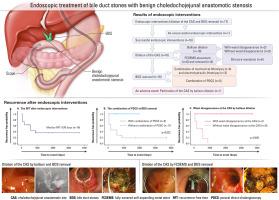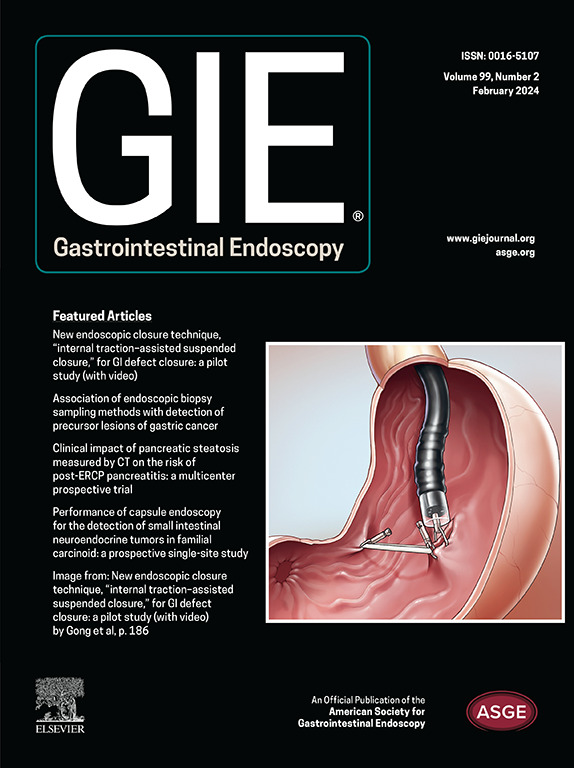Endoscopic treatment of bile duct stones with benign choledochojejunal anastomotic stenosis
IF 6.7
1区 医学
Q1 GASTROENTEROLOGY & HEPATOLOGY
引用次数: 0
Abstract
Background and Aims
Endoscopic interventions for bile duct stones (BDSs) with benign choledochojejunal anastomotic stenosis (bCJS) are challenging. Therefore, we investigated endoscopic interventions for BDSs with bCJS.
Methods
Seventeen patients with BDSs with bCJS were retrospectively analyzed. Patient characteristics, technical success, adverse events (AEs), and recurrence were evaluated.
Results
In 17 patients, the median diameters of the bile duct and BDSs were both 8 mm. The median number of BDSs was 3. The technical success rate was 94% (16/17). Ten patients underwent balloon dilation at the choledochojejunal anastomotic site (CAS), the median diameter of balloon dilation was 10.5 mm, and waist disappearance was achieved in 2. Six patients had fully covered self-expandable metal stents (FCSEMSs) with a diameter of 10 mm placed at the CAS. BDSs were removed after balloon dilation or FCSEMS removal, and 6 of 16 patients were treated with a combination of lithotripsy and 5 with peroral direct cholangioscopy (PDCS). Regarding AEs, perforation at the CAS by balloon dilation occurred in 1 patient. The median follow-up was 3701 days. Nine of 16 patients (56%) had recurrence. The patients treated with a combination of PDCS at BDS removal (P = .022) and waist disappearance at the CAS by balloon dilation (P = .035) had significantly fewer recurrences.
Conclusions
Endoscopic interventions for BDSs with bCJS are useful and relatively safe; however, long-term follow-up showed frequent recurrences. Recurrence was common in patients not treated with the combination of PDCS at BDS removal and those without waist disappearance at the CAS by balloon dilation.

胆总管结石伴良性胆总管空肠吻合口狭窄的内窥镜治疗。
[背景和目的]:对伴有良性胆总管空肠吻合口狭窄(bCJS)的胆总管结石(BDS)进行内镜介入治疗具有挑战性。因此,我们对胆总管结石伴良性胆总管吻合口狭窄(bCJS)的内镜介入治疗进行了研究。方法我们对 17 例伴有 bCJS 的 BDS 患者进行了回顾性分析。评估了患者特征、技术成功率、不良事件(AEs)和复发情况。结果在 17 例患者中,胆管和 BDS 的中位直径均为 8 毫米。技术成功率为 94%(16/17)。10 名患者在胆总管空肠吻合口(CAS)处进行了球囊扩张,球囊扩张的中位直径为 10.5 毫米,2 名患者的腰部消失。在球囊扩张或移除 FCSEMS 后移除 BDS,16 名患者中有 6 人接受了联合碎石治疗,5 人接受了经口直接胆道镜检查(PDCS)。关于AE,1名患者因球囊扩张导致CAS穿孔。中位随访时间为 3701 天。16 例患者中有 9 例(56%)复发。在 BDS 移除时联合使用 PDCS(P=0.022)和通过球囊扩张使 CAS 腰部消失(P=0.035)治疗的患者复发率明显较低。结论对伴有 bCJS 的 BDS 进行内镜干预是有用的,也是相对安全的;但长期随访显示复发率很高。在 BDS 清除时未联合使用 PDCS 治疗的患者和在 CAS 上未通过球囊扩张使腰部消失的患者中,复发很常见。
本文章由计算机程序翻译,如有差异,请以英文原文为准。
求助全文
约1分钟内获得全文
求助全文
来源期刊

Gastrointestinal endoscopy
医学-胃肠肝病学
CiteScore
10.30
自引率
7.80%
发文量
1441
审稿时长
38 days
期刊介绍:
Gastrointestinal Endoscopy is a journal publishing original, peer-reviewed articles on endoscopic procedures for studying, diagnosing, and treating digestive diseases. It covers outcomes research, prospective studies, and controlled trials of new endoscopic instruments and treatment methods. The online features include full-text articles, video and audio clips, and MEDLINE links. The journal serves as an international forum for the latest developments in the specialty, offering challenging reports from authorities worldwide. It also publishes abstracts of significant articles from other clinical publications, accompanied by expert commentaries.
 求助内容:
求助内容: 应助结果提醒方式:
应助结果提醒方式:


